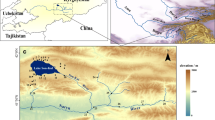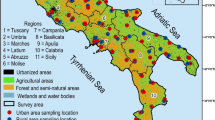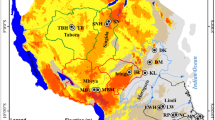Abstract
After decades of intensive application to the croplands of the lower and middle Sinú River valleys in Córdoba Department, an area of important agricultural activity, organochlorine pesticides (OCPs) were officially banned from agricultural use in Colombia in the 1990s. Until now, no studies of the OCP residue levels and their vertical distributions in the soils of this area had been conducted. In the present study, 83 representative topsoil samples (0–20-cm depth) and four soil cores were collected. The OCP concentrations were quantified via gas chromatography with electron capture detection. The resulting data indicate that the principal pesticide residues in the soil samples from both the middle and lower Sinú River basin were 4,4′-DDT (1.78 ± 4.99 μg kg−1), 4,4′-DDD (3.55 ± 8.27 μg kg−1), α-chlordane (80.0 ± 200.0 μg kg−1), and lindane (280 ± 870.0 μg kg−1), which accounted for approximately 80 % of the total residues detected in both regions. Other pesticide residues, such as β-BCH and β-endosulfan (0.11 ± 0.4 and 2.91 ± 20 μg kg−1, respectively), were also detected. The presence of these organochloride pesticides could be attributed to past agricultural applications and/or the adulteration of pesticides that are not banned. Soil profiles from almost all sampled sites indicate that organochlorine residues remain in surface layers. Because these compounds are highly toxic, persist in the environment, and are strongly enriched through the food chain, these results indicate a substantial environmental risk from organochlorine pesticides in the study area.



Similar content being viewed by others
References
Aiyesanmi, A. F., & Idowu, G. A. (2012). Organochlorine pesticides residues in soil of cocoa farms in Ondo State Central District, Nigeria. Environment and Natural Resources Research, 2(2), 65–73.
Al-Wabel, M. I., El-Saeid, M. H., Al-Turki, A. M., & Abdel-Nasser, G. (2011). Monitoring of pesticide residues in Saudi Arabia agricultural soils. Research Journal of Environmental Sciences, 5, 269–278.
Becker, S., Halsall, C. J., Tych, W., Kallenborn, R., Schlabach, M., & Man, S. (2012). Changing sources and environmental factors reduce the rates of decline of organochlorine pesticides in the Arctic atmosphere. Atmospheric Chemistry and Physics, 12, 4033–4044.
Betancourt, J., & Ramírez-Triana, G. (2005). Estudio de los procesos relacionados con la presencia de plaguicidas organoclorados en la Ciénaga Grande de Santa Marta. Boletín de Investigaciones Marinas y Costeras, 34(1), 121–139.
Bidleman, T., & Leone, A. (2004). Soil–air exchange of organochlorine pesticides in the Southern United States. Environmental Pollution, 128(1–2), 49–57.
Bossi, R., Laesen, B., & Premazze, G. (1992). Polychlorinated biphenyl congeners and other chlorinated hydrocarbons in bottom sediment cores of lake Garden (Italy). Science of the Total Environment, 121, 77–93.
Bouwman, H. (2004). South Africa and the Stockholm convention on persistent organic pollutants. South African Journal of Science, 100, 323–328.
Cantu-Soto, E. U., Meza-Montenegro, M., Valenzuela-Quintanar, A. I., Félix-Fuentes, A., Grajeda-Cota, P., Balderas-Cortes, J., Osorio-Rosas, C., Acuña-García, G., & Aguilar-podaca, M. (2011). Residues of organochlorine pesticides in soils from the Southern Sonora, Mexico. Bulletin of Environmental Contamination and Toxicology, 87(5), 556–560.
Castaneda, A. R., & Bhuiyan, S. I. (1996). Groundwater contamination by ricefield pesticides and some influencing factors. Journal environmental Science Health A, 31, 83–99.
Cavanagh, J. E., Burns, K. A., Burnskill, G. J., & Coventry, R. J. (1999). Organochlorine pesticide residues in soils and sediments of the Herbert and Burdekin River regions. North Queensland-implications for contamination of the Great Barrier Reef. Marine Pollution Bulletin, 39, 367–375.
Cocco, P., Blair, A., Congia, P., Saba, G., Flore, C., Ecca, M. R., & Palmas, C. (1997). Proportional mortality of dichlorodiphenyl-trichloroethene (DDT) workers: a preliminary report. Archives Environmental Health, 52, 299–303.
DTSC, Department of Toxic Substances Control, California Environmental Protection Agency. (2010). Proven technologies and remedies guidance remediation of organochlorine pesticides in soil. http://www.dtsc.ca.gov/SiteCleanup/upload/OCP_022610_final.pdf.
Edmunds, T. (2007). Estimación De La Contaminación Ambiental Por Plaguicidas en Suelos Agricolas de la Isla De Pascua, V región, Tesis-Universidad de Chile, facultad de ciencias.
EPA, Environmental Protection Agency. (1980). Manual of analytical methods for the analysis of pesticide residues in human and environmental samples. Editorial Panel. pp 566.
Feria, J., Marrugo, J., & Gonzalez, H. (2010). Heavy metals in Sinú river, Department of Córdoba, Colombia, South America. Revista de la facultad de Ingeniería de la Universidad de Antioquia, 55, 35–44.
Gaw, S.K., Wilkins, A.L., Kim, N.D., Palmer, G.T., & Robinson, P. (2006). Trace element and ΣDDT concentrations in horticultural soils from the Tasman, Waikato and Auckland regions of New Zealand. Science of the Total Environment, 355, 31–47.
Ghadiri, H., & Rose, C. W. (2001). Degradation of endosulfan in a clay soil from cotton farms of western Queensland. Journal Environmental Manager, 62(1), 55–69.
Gong, Z. M., Xu, F. L., Dawson, R., Cao, J., Liu, W. X., Li, B. G., Shen, W. R., Zhang, W. J., Qin, B. P., Sun, R., & Tao, S. (2004). Residues of hexachlorocyclohexane isomers and their distribution characteristics in soils in the Tianjin area, China. Archives of Environmental Contamination and Toxicology, 46, 432–437.
Hong, N., Shan, C., Ling, J., & Hui, Z. (2011). Incidence of organochlorine pesticides in soils of Shenzhen, China. Journal of Environmental Monitoring, 13, 951–956.
Jiang, Y., Wang, X., Jia, Y., Wang, F., Wu, M., Sheng, G., & Fu, J. (2009). Occurrence, distribution and possible sources of organochlorine pesticides in agricultural soil of Shanghai, China. Journal of Hazardous Materials, 170, 989–997.
Kannan, K., Battula, S., Loganathan, B.G., Hong, C.-S., Lam, W.H., Villeneuve, D.L. et al. (2003). Trace organic contaminants, including toxaphene and trifluralin, in cotton field soils from Georgia and South Carolina, USA. Archives of Environmental Contamination and Toxicology, 45, 30–36.
Kishimba, M.A., Henry, L., Mwevura, H., Mmochi, A.J., Mihale, M., & Hellar, H. (2004). The status of pesticide pollution in Tanzania. Talanta, 64, 48–53.
Kookana, R. (2009). The role of black carbon in environmental fate of persistent organic pollutants (POPs) in soils and their effect on food safety. FFTC Publications and Website on Asian Agriculture, Extension Bulletin Eb621. http://www.agnet.org/htmlarea_file/library/20110804154803/eb621.pdf.
Krauss, M., Wilcke, W., & Zech, W. (2000). Polycyclic aromatic hydrocarbons and polychlorinated biphenyls in forest soils: depth distribution as indicator of different fate. Environmental Pollution, 110, 79–88.
Kumar, B., Richa, G., Gargi, G., Meenu, M., Singh, S. K., Dev, P., Kumar, S., Chakraborty, P., Sajwan, K. S., & Sharma, C. S. (2011). Residues of persistent organochlorine pesticides in soils from variable cropping pattern agriculture areas. Organohalogen Compounds, 73, 1851–1854.
Kumar, M., & Philip, L. (2006). Adsorption and desorption characteristics of hydrophobic pesticide endosulfan in four Indian soils. Chemosphere, 62, 1064–1077.
Leys, J. F., Larney, F. J., Müller, J. F., Raupach, M. R., McTainsh, M. R., & Lynch, G. H. (1998). Anthropogenic dust and endosulfan emissions on cotton farm in northern New South Wales, Australia. Science of The Total Environment, 220, 55–70.
Li, Q. B., Zhang, H. B., Luo, Y. M., Song, J., Wu, L. H., & Ma, J. M. (2008). Residues of DDTs and their spatial distribution characteristics in soils from the Yangtze River Delta, China. Environmental Toxicology & Chemistry, 27, 24–30.
Li, X., Zhu, Y., Liu, X., Fu, S., Xu, X., & Cheng, H. (2006). Distribution of HCHs and DDTs in soils from Beijing city, China. Archives of Environmental Contamination and Toxicology, 51, 329–336.
Loganathan, B., Lam, P. (2011). Global contamination trends of persistent organic chemicals. CRC Press, Taylor & Francis Group, Print ISBN: 978-1-4398-3830-3.
Malik, A., Ojha, P., & Singh, K. (2009). Levels and distribution of persistent organochlorine pesticide residues in water and sediments of Gomti River (India)—a tributary of the Ganges River. Environmental Monitoring and Assessment, 148, 421–435.
Marrugo, J., Ponguta, B., & Lans, E. (2008). Estudio de la contaminación por pesticidas organoclorados en aguas de la ciénaga grande del valle bajo del río Sinú. Temas Agrarios, 13(1), 49–56.
Marrugo, L. (2005). Determinación de los niveles de pesticidas en los ríos Sinú, san Jorge y canalete, con el fin de darle soporte al diagnostico del plan de ordenamiento Territorial de las cuencas. CVS - Universidad de Córdoba.
Meijer, S. N., Ockenden, W. A., Sweetman, A., Breivik, K., Grimalt, J. O., & Jones, K. C. (2003). Global distribution and budget of PCBs and HCB in background surface soils; implications for sources and environmental processes. Environmental Science & Technology, 37, 667–672.
Miglioranza, K. S. B., Aizpún de Moreno, J. E., & Moreno, V. J. (2003). Dynamics of organochlorine pesticides in soils from a southeastern region of Argentina. Environmental Toxicology and Chemistry, 22, 712–717.
Mishra, K., Sharma, R. C., & Kumar, S. (2012). Contamination levels and spatial distribution of organochlorine pesticides in soils from India. Ecotoxicology and Environmental Safety, 76(2), 215–225.
Nakata, H., Hirakawa, Y., Kawazoe, M., Nakabo, T., Arizono, K., Abe, S.I. et al. (2005). Concentrations and compositions of organochlorine contaminants in sediments, soils, crustaceans, fishes and birds collected from Lake Tai, Hangzhou Bay and Shanghai city region, China. Environment Pollution, 133, 415–429.
Racke, K., Skidmore, M., & Hamilton, D. (1997). Pesticide fate in tropical soils. Pure and Applied Chemistry, 69(6), 1349–1371.
Reeuwij, L.P. (2002). Procedures for soil analysis. Sixth edition. International Soil Reference and Information Centre—Food and Agriculture Organization of the United Nations. Technical Paper 9.
Rissato, S., Galhiane, M., Ximenes, V., de Andrade, R., Talamoni, J., Libânio, M., de Almeida, M., Apon, B., & Cavalari, A. (2006). Organochlorine pesticides and polychlorinated biphenyls in soil and water samples in the Northeastern part of São Paulo State, Brazil. Chemosphere, 65(11), 1949–1958.
Rice, C., Nochetto, C., & Zara, P. (2002). Volatilization of trifluralin, atrazine, metolachlor, chlorpyrifos, α-endosulfan and β-endosulfan from freshly tilled soil. Journal of Agricultural and Food Chemistry, 50, 4009–4017.
Ruiz, M., Bernal, G., & Polania, J. (2008). Influencia del Río Sinú y El Mar Caribe en el Sistema Lagunar de Cispatá. Santa marta: Instituto de Investigaciones Marinas y Costeras–Invemar.
Sethunathan, N., Megharaj, M., Chen, Z., Singh, N., Kookana, R. S., & Naidu, R. (2002). Persistence of endosulfan and endosulfan sulfate in soil as affected by moisture regime and organic matter addition. Bulletin of Environmental Contamination and Toxicology, 68, 725–731.
Ssebugere, P., Wasswa, J., Mbabazi, J., Nyanzi, S., Kiremire, B., & Marco, J. (2010). Organochlorine pesticides in soils from south-western Uganda. Chemosphere, 78, 1250–1255.
Tao, S., Li, L., Ding, J., Zhong, J., Zhang, D., Lu, Y., Yang, Y., Wang, X., Li, X., Cao, J., Lu, X., & Liu, W. (2011). Mobilization of soil-bound residue of organochlorine pesticides and polycyclic aromatic hydrocarbons in an in vitro gastrointestinal model. Environmental Science & Technology, 45(3), 1127–1132.
Thomas, J. E., Ou, L. T., & All-Agely, A. (2008). DDE remediation and degradation. Reviews of Environmental Contamination and Toxicology, 194, 55–69.
US EPA (2002). Endosulfan RED facts. US EPA, Office of Prevention, Pesticides. http://www.epa.gov/oppsrrd1/REDs/factsheets/endosulfan_fs.html.
US EPA (2001). Environmental fate and ecological risk assessment for the reregistration eligibility decision on endosulfan. US EPA, Office of Prevention, Pesticides, and Toxic Substances.
Vig, K., Singh, D., Agarwal, H., Dhawan, A., & Dureja, P. (2001). Insecticide residues in cotton crop soil. Journal environmental Science Health B, 36(4), 421–434.
Villanneau, E., Saby, N., Arrouays, D., Jolivet, C., Boulonne, L., Caria, G., Barriuso, E., Bispo, A., & Briand, O. (2009). Spatial distribution of lindane in topsoil of Northern France. Chemosphere, 77, 1249–1255.
Viloria, J. (2004). La economía del departamento de Córdoba: ganadería y minería como sectores claves. Centro de estudios económicos regionales. Cartagena: Banco de la Republica.
Waliszewski, M., & Infanzón, R. (2003). Diferencias en Concentración de Plaguicidas Organoclorados Persistentes en Suelo, Paja y Granos De Trigo. Revista Internacional de Contaminación Ambiental, 19(1), 5–11.
Wang, F., Jiang, X., Bian, Y. R., Yao, F. X., Gao, H. J., Yu, G. F., Munch, J. C., & Schroll, R. (2007a). Organochlorine pesticides in soils under different land usage in the Taihu Lake region, China. Journal of Environmental Sciences (China), 19, 584–590.
Wang, T., Lu, Y., Shi, Y., Giesy, J., & Luo, W. (2007b). Organochlorine pesticides in soils around Guanting Reservoir, China. Environmental Geochemistry and Health, 29, 491–501.
Weaver, T. B., Ghadiri, H., Hulugalle, N. R., & Harden, S. (2012). Organochlorine pesticides in soil under irrigated cotton farming systems in Vertisols of the Namoi Valley, north-western New South Wales, Australia. Chemosphere, 88(3), 336–343.
Weber, J., Halsall, C., Muir, D., Teixeira, C., Small, J., Solomon, K., Hermanson, M., Hung, H., & Bidleman, T. (2010). Endosulfan, a global pesticide: a review of its fate in the environment and occurrence in the Arctic. Science of the Total Environment, 408, 2966–2984.
Wong, F., Alegria, H., & Bidlemana, T. (2010). Organochlorine pesticides in soils of Mexico and the potential for soil–air exchange. Environmental Pollution, 158(3), 749–755.
Xu, B., Jiany, G., Yongxi, Z., & Haibo, L. (1994). Behaviour of DDT and DDE in Philippine soil under field conditions. Journal of environmental science and health part B, 29, 25–35.
Yang, D., Qi, S. H., Zhang, J. Q., Tan, L. Z., Zhang, J. P., Zhang, Y., Xu, F., Xing, X. L., Hu, Y., Chen, W., Yang, J. H., & Xu, M. H. (2012). Residues of organochlorine pesticides (OCPs) in agricultural soils of Zhangzhou City, China. Pedosphere, 22(2), 178–189.
Zhang, G., Li, J., Cheng, H., Li, X., Xu, W., & Jones, K. C. (2007). Distribution of organochlorine pesticides in the Northern South China Sea: implications for land outflow and air–sea exchange. Environmental Science & Technology, 41, 3884–3890.
Zhang, H., Luo, Y., & Li, O. (2009). Burden and depth distribution of organochlorine pesticides in the soil profiles of Yangtze River Delta Region, China: implication for sources and vertical transportation. Geoderma, 153, 69–75.
Zhu, Y., Liu, H., Xi, Z., Cheng, H., & Xu, X. (2005). Organochlorine pesticides (DDTs and HCHs) in soils from the outskirts of Beijing, China. Chesmosphere, 60, 770–778.
Acknowledgements
The authors thank the University of Cordoba for financial support through the contract FCB-03-06. They also express their gratitude to the farmers in the region of Cordoba, Colombia for their special support.
Author information
Authors and Affiliations
Corresponding author
Rights and permissions
About this article
Cite this article
Marrugo-Negrete, J.L., Navarro-Frómeta, A.E. & Urango-Cardenas, I.D. Organochlorine Pesticides in Soils from the Middle and Lower Sinú River Basin (Córdoba, Colombia). Water Air Soil Pollut 225, 2053 (2014). https://doi.org/10.1007/s11270-014-2053-3
Received:
Accepted:
Published:
DOI: https://doi.org/10.1007/s11270-014-2053-3




